 It's characterized by a rise in freak events and a general increase in harming. 
We used the term “swooning flowers of maidenhood” last time we read a Mignon Eberhart novel, and she holds true to form with 1949's House of Storm. It's set on a small Caribbean island—so small in fact that it's named for the family that runs a plantation there. Murder occurs as a tropical storm shuts down transport and strands swooning flower and bride-to-be Nonie Hovenden with others in a large house. The real storm is (of course) emotional and deals with a weighty romantic subplot centered around her wishing to escape her pending nuptials so she can marry the man she really loves—who soon becomes murder suspect number one.
It's less complicated than it sounds. The murder plotline is interesting enough and the atmosphere is reasonably well rendered, but all you really need to know is that Eberhart operated at the nexus of suspense and romance, and here Nonie's breathless flutterings are almost intense enough to riffle the book's pages. If you can take that sort of thing, you'll like House of Storm. We kept making moments to finish it despite our reservations, so we have to call it a success. But we're suckers for tropical island fiction—even when there's breastbeating romance at its core—so take our endorsement with a grain of salt.
 Sorry to scare you. Just triple checking. So it's a firm no on that dinner invitation. Any chance you'd meet me for coffee? 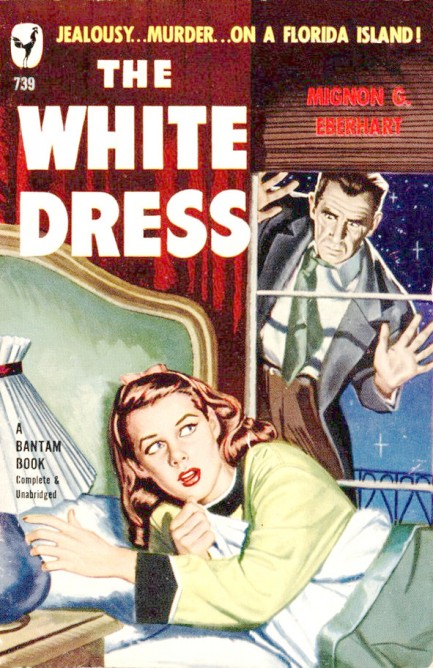
In one of our favorite episodes of The Simpsons, Bart is on edge because he's being stalked by Sideshow Bob, who wants to kill him. Homer decides to show Bart a new hockey mask and chainsaw he's bought. He bursts into Bart's room wearing the mask, brandishing the roaring chainsaw, and yells, “Hey Bart! Check out my new hockey mask and chainsaw!” Bart screams in terror, and Homer, realizing he's chosen the worst possible time to show off these purchases, backs out of the room apologizing. Amazingly, a scene exactly like that occurs in Mignon G. Eberhart's 1946 Miami based parlor mystery The White Dress, except protagonist Marny Sanderson is terrified of a killer who's been stalking her while wearing a black raincoat with a black scarf wrapped around his head. Another character dons the same costume and walks unannounced into her room with the intention of confirming her description of the killer. He doesn't yell, “Hey Marny, did he look anything like THIS!” But he might as well have. His subsequent apology: “My God, how stupid of me. It never occurred to me that I might frighten you.” We got a hearty laugh from that.
None of this is to say The White Dress is bad, but it's certainly obtuse in parts. It's also old fashioned, even for a novel from the period. Authors like Dashiell Hammett had debuted more than a decade earlier and changed the conventions of detective novels, peopling them with hard-boiled men and women. Swooning flowers of maidenhood like Marny continued to exist in the sub-genre of romantic mysteries Eberhart specialized in, but ladies of leisure faced with murder don't react in proactive ways. That's where the romance comes in, as Marny attracts the attentions of a dashing Navy flier who makes it his latest mission to swoop down and save the hot damsel in distress. Though more decisive than Marny, his approach to the mystery is often ridiculous. Without getting deeply into it, suffice it to say he has a couple of dangerously cockeyed brainstorms. But you know what? For all its quirks we still liked The White Dress. It's a window onto a romanticized realm we've never understood. Maybe it never truly existed. But viewed anthropologically, it's engaging and amusing.
 All her problems turned out to be relative. 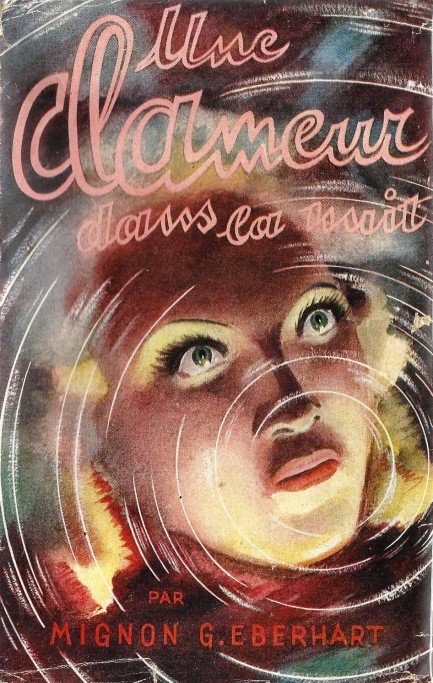
Cool French cover art for Mignon G. Eberhart's 1937 mystery novel Danger in the Dark, also known as Hand in Glove, and released in France by Presses de la Cité in 1947 as Une clameur dan la nuit, which translates as “a scream in the night.” A man means to stop the distant cousin he loves from getting married, but when her fiancée turns up dead the two relatives decide to make the scene look like a robbery to avoid the police suspecting them of murder. But who did the killing? Eberhart had a long and distinguished literary career, typically mixing her mysteries with strong elements of romance and ending up with Christie-meets-Harlequin. This is a prime example, but a well reviewed book.
 In case of emergency—jump. 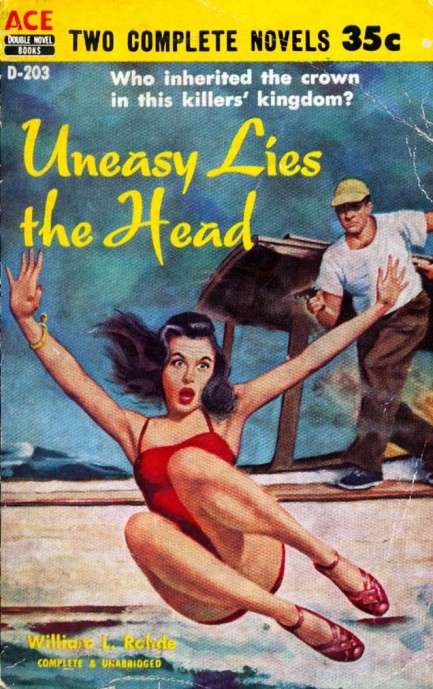 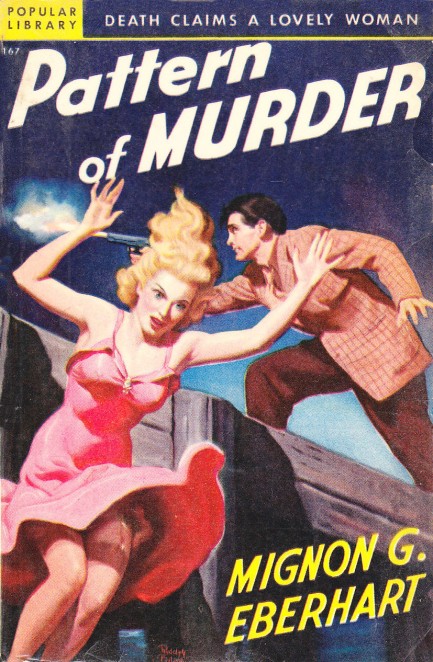
Consider these a small subset of our collection of falling covers—call them desperate leaps. The interesting part is if the gunmen weren’t there, both women would look like they were having fun. The art is by Harry Barton, 1957, and Rudolph Belarski, 1948.
 Ottoman, Ottoman, Otto mighty mighty good man. 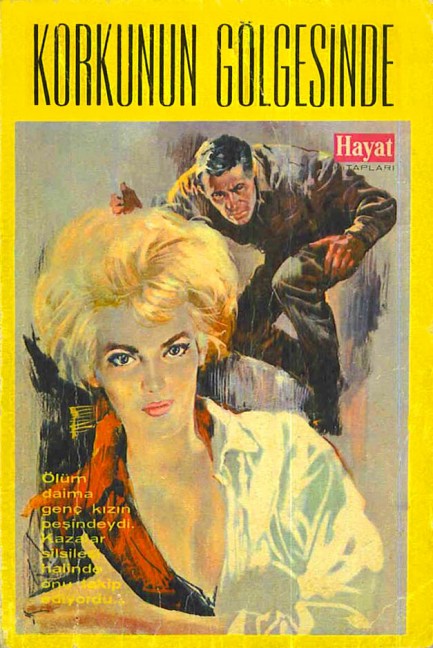 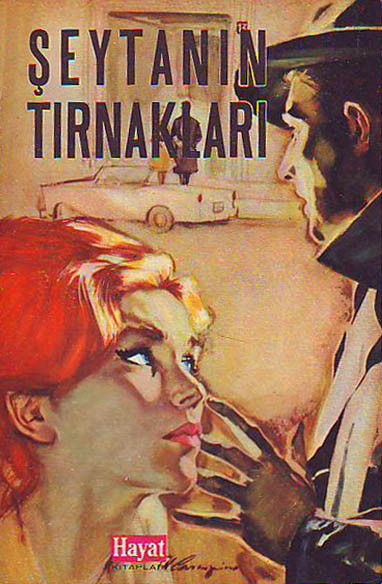 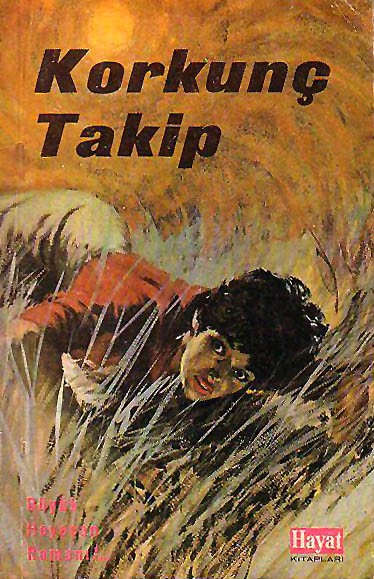 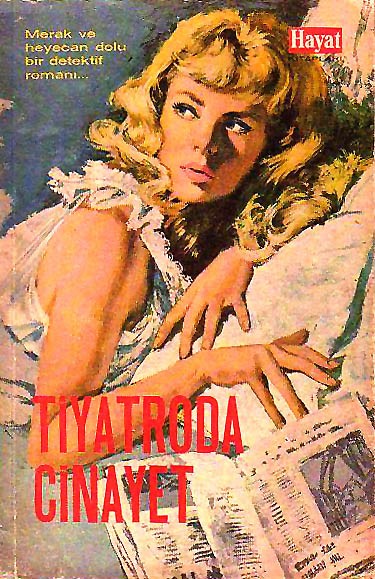 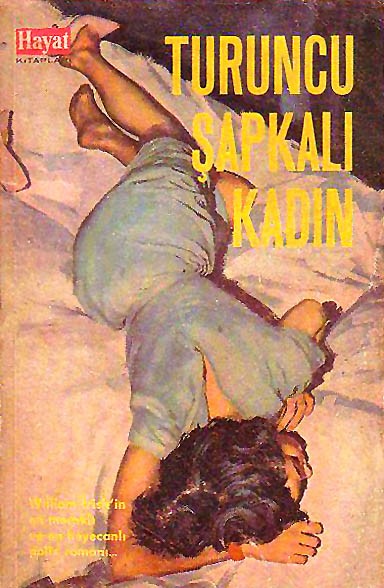 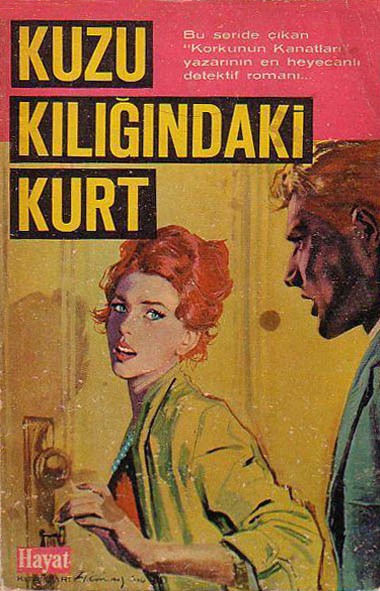    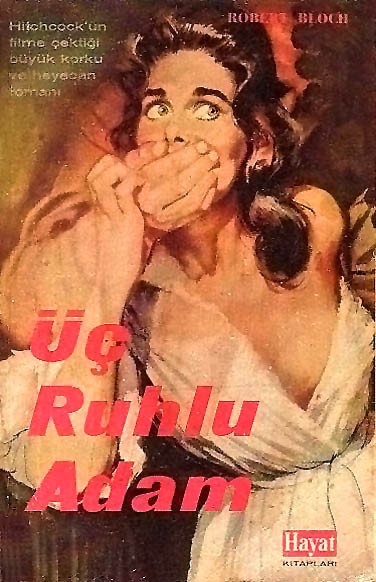
Assorted Turkish language pulps published by the pop culture magazine Hayat, circa 1960s and early 1970s. The authors are, top to bottom, Allison L. Burks, Gerald de Jean, William McGivern, Ngaio Marsh, William Irish, Mignon G. Eberhart, Nora Roberts, Ellery Queen (aka Frederic Dannay and Manfred Bennington Lee, aka Daniel Nathan and Manford Lepofsky), John Dickson Carr, and Robert Bloch.
 Not the hair! Not the hair! 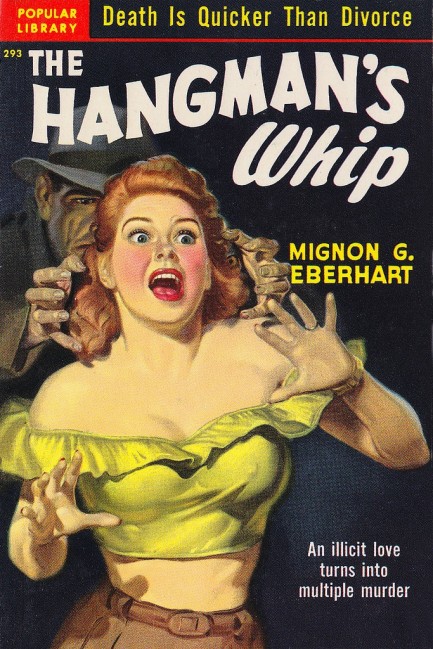
Mignonette Eberhart was an acclaimed mid-century crime writer who was the first to create a female sleuth, which she did in her book The Patient in Room 18. This was a year before Agatha Christie created her immortal sleuth Jane Marple in Murder at the Vicarage. Eberhart soon veered away from pure whodunits and into romance-mysteries that usually centered on good women involved with bad men. The tagline of 1940’s The Hangman’s Whip—“Death is quicker than divorce”—gets that idea across succinctly. It was in these writings that Eberhart flourished, becoming internationally known and highly paid. She authored fifty-nine books, six of which were adapted to film, along with three of her short stories, and in 1971 she earned the Mystery Writers of America Grand Master Award. Eberhart died in 1996, but she changed the romance genre and entertained millions while doing it. Her books—including The Hangman’s Whip—remain widely available.
|
 |

The headlines that mattered yesteryear.
2003—Hope Dies
Film legend Bob Hope dies of pneumonia two months after celebrating his 100th birthday. 1945—Churchill Given the Sack
In spite of admiring Winston Churchill as a great wartime leader, Britons elect
Clement Attlee the nation's new prime minister in a sweeping victory for the Labour Party over the Conservatives. 1952—Evita Peron Dies
Eva Duarte de Peron, aka Evita, wife of the president of the Argentine Republic, dies from cancer at age 33. Evita had brought the working classes into a position of political power never witnessed before, but was hated by the nation's powerful military class. She is lain to rest in Milan, Italy in a secret grave under a nun's name, but is eventually returned to Argentina for reburial beside her husband in 1974. 1943—Mussolini Calls It Quits
Italian dictator Benito Mussolini steps down as head of the armed forces and the government. It soon becomes clear that Il Duce did not relinquish power voluntarily, but was forced to resign after former Fascist colleagues turned against him. He is later installed by Germany as leader of the Italian Social Republic in the north of the country, but is killed by partisans in 1945.
|

|
|

It's easy. We have an uploader that makes it a snap. Use it to submit your art, text, header, and subhead. Your post can be funny, serious, or anything in between, as long as it's vintage pulp. You'll get a byline and experience the fleeting pride of free authorship. We'll edit your post for typos, but the rest is up to you. Click here to give us your best shot.

|
|


























































































